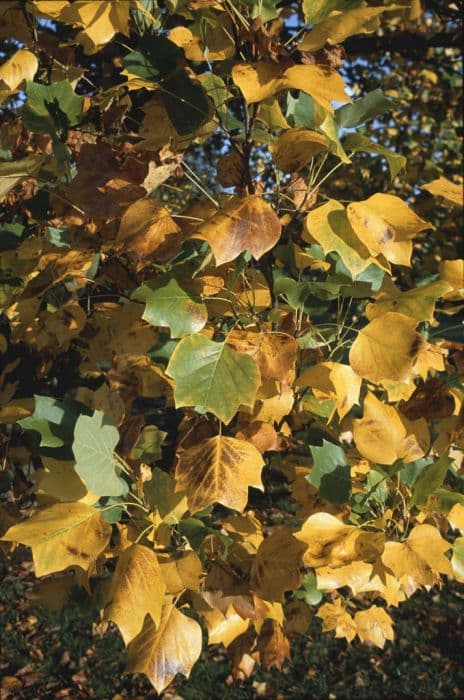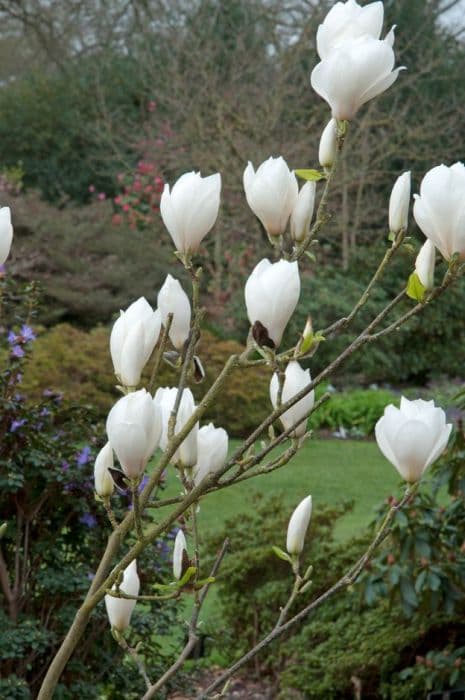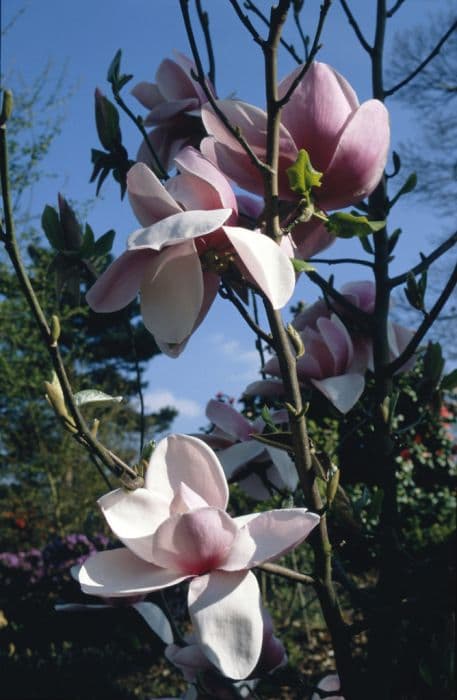Gold Star Magnolia Magnolia 'Gold Star'

ABOUT
Magnolia 'Gold Star' exhibits a stunning display of large, star-shaped flowers that herald the arrival of spring. These flowers are a warm, creamy yellow color with a slight pale tone, and typically have many elongated petals arranged in an attractive, radiating pattern. The petals have a gentle, satiny finish and provide a subtle yet noticeable contrast against the lush green foliage. The leaves of the 'Gold Star' magnolia are likewise impressive; they are broad, glossy, and have an oval to oblong shape with a rich green color that serves as an ideal backdrop for the striking blossoms. After the flowering period, the plant may produce cone-shaped fruit that exhibits a reddish hue as it matures, adding further interest to the plant's appearance. Throughout the growing season, the 'Gold Star' magnolia presents a poised and elegant habit, making it a popular choice for gardens seeking a plant with both visual appeal and a touch of sophistication.
About this plant
 Names
NamesFamily
Magnoliaceae
Synonyms
Gold Star Magnolia
Common names
Magnolia 'Gold Star'.
 Toxicity
ToxicityTo humans
Magnolias, including Magnolia 'Gold Star', are not commonly known to be toxic to humans. There’s generally no severe risk if someone ingests parts of this plant. However, as with any non-food plant, eating parts of a magnolia may cause mild stomach upset or an allergic reaction in sensitive individuals.
To pets
Magnolias, including Magnolia 'Gold Star', are considered non-toxic to pets such as dogs and cats. While not typically harmful, if pets ingest large quantities of magnolia leaves or flowers, they may experience mild gastrointestinal upset. Signs of this could include vomiting or diarrhea, but serious toxicity is rare.
 Characteristics
CharacteristicsLife cycle
Perennials
Foliage type
Deciduous
Color of leaves
Green
Flower color
Yellow
Height
10-20 feet (3-6 meters)
Spread
10-20 feet (3-6 meters)
Plant type
Tree
Hardiness zones
5-9
Native area
North America
Benefits
 General Benefits
General Benefits- Ornamental Value: Magnolia 'Gold Star' is a widely appreciated ornamental tree, prized for its large, star-shaped yellow flowers that bloom in early spring, adding visual appeal to gardens and landscapes.
- Shade Provider: The tree grows to a medium size and its lush foliage provides ample shade, making it ideal for sunny gardens or parks.
- Wildlife Attraction: The flowers produce a light, sweet fragrance that attracts bees, butterflies, and birds, supporting local ecosystems.
- Low Maintenance: Once established, Magnolia 'Gold Star' requires relatively little care, tolerating a variety of soil conditions and withstanding occasional droughts.
- Privacy Screen: Due to its dense growth, the tree can serve as an effective privacy screen or windbreak when planted in rows or groups.
- Seasonal Interest: Its striking flowers in the spring and attractive green foliage through summer, which may turn golden-brown in fall, provide multi-season interest.
- Urban Tolerant: Magnolia 'Gold Star' can thrive in urban settings, coping well with pollution and often used in city landscaping.
- Low Allergen: This plant is not known for producing significant amounts of pollen, making it friendly for people with allergies.
 Medical Properties
Medical PropertiesThis plant is not used for medical purposes.
 Air-purifying Qualities
Air-purifying QualitiesThis plant is not specifically known for air purifying qualities.
 Other Uses
Other Uses- Magnolia 'Gold Star' petals can be used to craft eco-friendly confetti for weddings or celebrations, being biodegradable and adding a natural flair to any event.
- The bark and branches of Magnolia 'Gold Star' can serve as a natural dye source for fabrics, providing a range of earthy tones.
- Wood from the Magnolia 'Gold Star' tree can be utilized in fine woodworking or furniture making, prized for its rich color and grain.
- Leaves of the Magnolia 'Gold Star' can be incorporated into thematic floral arrangements or wreaths for decorative purposes because of their glossy, evergreen appearance.
- Pressed flowers and leaves of Magnolia 'Gold Star' can be used in botanical art or herbarium collections, admired for their aesthetic qualities.
- Thick leaves from the Magnolia 'Gold Star' can be used as a natural serving dish for appetizers at garden parties, adding a unique and sustainable touch.
- The aromatic wood of the Magnolia 'Gold Star' is sometimes used in perfumery for its woody and subtle floral undertones.
- Dried Magnolia 'Gold Star' seed pods can be integrated into potpourri blends, contributing to the visual and olfactory composition of the mix.
- Magnolia 'Gold Star' branches may be fashioned into rustic plant supports or trellises in the garden, blending seamlessly into the landscape.
- The distinctive seed cones of the Magnolia 'Gold Star' can be used as educational tools in botany classes to demonstrate seed dispersal mechanisms.
Interesting Facts
 Feng Shui
Feng ShuiMagnolia is not used in Feng Shui practice.
 Zodiac Sign Compitability
Zodiac Sign CompitabilityMagnolia is not used in astrology practice.
 Plant Symbolism
Plant Symbolism- Nobility: The magnificence of the Magnolia 'Gold Star' flower symbolizes dignity and splendid beauty, often associated with a noble spirit.
- Perseverance: As a plant that has existed for millennia, magnolias represent endurance and the ability to withstand difficult conditions.
- Femininity: Their graceful and delicate appearance is often tied to feminine qualities of softness, gentleness, and beauty.
- Purity: The magnolia's white flowers are traditionally linked with purity and innocence, making them a common choice for bridal bouquets and decorations.
- Peace and Tranquility: Magnolias are believed to bring peace and calm to any setting, symbolizing a serene environment or state of mind.
 Water
WaterThe Star Magnolia requires consistent moisture and should be watered deeply once a week, allowing about 5 gallons of water to reach the roots. During hot and dry spells, the frequency of watering should be increased to twice a week, ensuring the soil remains moist but not waterlogged. For newly planted Star Magnolias, water every few days to help establish the root system, gradually decreasing to weekly waterings as the plant matures. Avoid overhead watering to minimize the risk of foliar diseases, and instead aim the water directly at the base of the plant.
 Light
LightThe Star Magnolia thrives best in full sun to partial shade conditions. Ideally, it should receive at least 4 hours of direct sunlight a day, but can also benefit from some afternoon shade in regions with intense heat. A spot that offers morning sunlight with some protection from harsh afternoon rays is excellent for promoting healthy growth and abundant flowering.
 Temperature
TemperatureThe Star Magnolia prefers temperate climates and can generally withstand temperatures as low as 20°F and as high as 90°F, but its ideal growing conditions are between 60°F and 75°F. It is important to protect the tree from late spring frosts that can damage early blooms. During extreme cold, it may be necessary to provide additional insulation to the roots to prevent freezing.
 Pruning
PruningPruning the Star Magnolia is mainly required to maintain shape and remove any dead or damaged wood. It's best to prune immediately after flowering to minimize disruption of next year's blooms, which are set on old wood. Prune sparingly, as this tree does not generally require heavy cutting back, and remove only what is necessary to keep the tree healthy and aesthetically pleasing.
 Cleaning
CleaningAs needed
 Soil
SoilMagnolia 'Gold Star,' commonly known as Star Magnolia, thrives in moist, well-draining, acidic to neutral soil with a pH range of 5.5 to 7.0. A rich loam-based mix with peat moss and compost is ideal. Ensure adequate organic matter for nutrient retention and air circulation to support root health.
 Repotting
RepottingStar Magnolias are slow-growing and do not require frequent repotting. They should be repotted every 3-5 years or when rootbound, which is apparent when roots grow through the drainage holes or circle the pot's interior.
 Humidity & Misting
Humidity & MistingStar Magnolia prefers moderate to high humidity levels but is adaptable to typical outdoor conditions. While it can withstand some dryness once established, prolonged low humidity can lead to leaf problems, so maintaining a relatively humid environment is beneficial.
 Suitable locations
Suitable locationsIndoor
Provide bright light, water well, protect from drafts.
Outdoor
Plant in sun or partial shade, shelter from harsh winds.
Hardiness zone
5-9 USDA
 Life cycle
Life cycleMagnolia 'Gold Star', also known simply as Gold Star Magnolia, begins its life cycle as a seed, which after dispersal germinates in fertile, well-drained soil under appropriate conditions of warmth and moisture. The seedling then emerges, developing a primary root system and foliage as it becomes a juvenile plant, during which it gradually acclimatizes to external conditions. As the plant matures, it enters the vegetative growth stage, forming a woody structure and extensive root system, while leaves and branches increase in size and number. Reaching maturity, the Gold Star Magnolia starts to bloom, producing star-shaped yellow flowers typically in early spring, which are then pollinated by insects, leading to the development of cone-like fruit. After pollination and fertilization, seeds are produced within the fruit, which upon maturity are released to the environment to propagate the next generation of magnolias. The plant continues to grow and bloom annually, often living for many years and reaching a substantial height and spread before eventually senescing and dying.
 Propogation
PropogationPropogation time
Spring-Early Summer
The Magnolia 'Gold Star', commonly referred to as the Gold Star Magnolia, is most effectively propagated through semi-hardwood cuttings. This method is best undertaken in late summer after the current season's growth has started to harden. Cuttings should be approximately 4 to 6 inches (10 to 15 cm) in length and include at least one set of leaves. The lower end of the cutting is dipped in rooting hormone before being placed in a mixture of half peat and half perlite or a similar well-draining medium. A plastic covering is often used to maintain humidity around the cutting, creating a mini-greenhouse effect. Root development can be expected in a few weeks, after which the new plants can eventually be transplanted into individual pots or a selected garden location.









